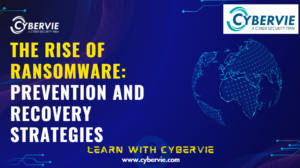Ransomware attacks have become increasingly prevalent, targeting individuals, businesses, and critical infrastructure. This blog will explore the tactics used by ransomware attackers, provide practical prevention strategies, and outline steps to take in case of a ransomware attack.
The Increasing Threat of Ransomware
- Ransomware Basics: Explain how ransomware works and the different types of attacks.
- Target Profiles: Discuss the typical targets of ransomware attacks (individuals, small businesses, large corporations).
- Financial Impact: Highlight the significant financial losses caused by ransomware incidents.
Prevention Strategies
- Strong Passwords and Security Practices: Emphasize the importance of creating strong, unique passwords and enabling MFA.
- Regular Software Updates: Keep operating systems, applications, and antivirus software up-to-date.
- Employee Training: Educate employees about phishing attempts, social engineering, and other common attack vectors.
- Network Security: Implement firewalls, intrusion detection systems, and other network security measures.
- Data Backup: Regularly back up important data to an offline storage device.
Recovery Strategies
- Incident Response Plan: Outline the steps to take in case of a ransomware attack, including isolating infected systems and contacting IT support.
- Data Recovery: Explain how to restore data from backups.
- Negotiation Tactics: Discuss the risks and challenges of paying a ransom.
- Learning from the Attack: Emphasize the importance of conducting a thorough investigation to prevent future attacks.
Conclusion
While ransomware attacks can be devastating, implementing robust prevention measures and having a well-defined recovery plan can significantly mitigate the impact. Staying informed about the latest ransomware trends and best practices is crucial for protecting yourself and your organization.
Join our future proof Cyber security training & internship program.







